 Our World
Our World  Our World
Our World  Movies and TV
Movies and TV The 10 Coolest Stars to Set Sail on The Love Boat
 History
History 10 Things You Didn’t Know About the American National Anthem
 Technology
Technology Top 10 Everyday Tech Buzzwords That Hide a Darker Past
 Humans
Humans 10 Everyday Human Behaviors That Are Actually Survival Instincts
 Animals
Animals 10 Animals That Humiliated and Harmed Historical Leaders
 History
History 10 Most Influential Protests in Modern History
 Creepy
Creepy 10 More Representations of Death from Myth, Legend, and Folktale
 Technology
Technology 10 Scientific Breakthroughs of 2025 That’ll Change Everything
 Our World
Our World 10 Ways Icelandic Culture Makes Other Countries Look Boring
 Our World
Our World 10 Ways Your Christmas Tree Is More Lit Than You Think
 Movies and TV
Movies and TV The 10 Coolest Stars to Set Sail on The Love Boat
 History
History 10 Things You Didn’t Know About the American National Anthem
Who's Behind Listverse?

Jamie Frater
Head Editor
Jamie founded Listverse due to an insatiable desire to share fascinating, obscure, and bizarre facts. He has been a guest speaker on numerous national radio and television stations and is a five time published author.
More About Us Technology
Technology Top 10 Everyday Tech Buzzwords That Hide a Darker Past
 Humans
Humans 10 Everyday Human Behaviors That Are Actually Survival Instincts
 Animals
Animals 10 Animals That Humiliated and Harmed Historical Leaders
 History
History 10 Most Influential Protests in Modern History
 Creepy
Creepy 10 More Representations of Death from Myth, Legend, and Folktale
 Technology
Technology 10 Scientific Breakthroughs of 2025 That’ll Change Everything
 Our World
Our World 10 Ways Icelandic Culture Makes Other Countries Look Boring
10 Tragic Prison and Asylum Fires
I have written several other fire-related lists for Listverse but never one on this topic. Prisons, and insane asylums are not the kind of buildings people typically think about when they consider fire safety for the occupants. But humans can die just as easily and quickly in a burning building that is a prison as they can in a factory or a school. In fact, they can die far more easily as they are, in most cases, locked inside the building and can only escape the fire if someone unlocks the doors holding them in. In addition, many older prisons and asylums had little to no fire safety warning or suppression systems and were constructed of wood and other combustible materials. Finally, prisons and asylums were (are) usually overcrowded and those that are in charge of their operation are far more inclined to worry about intentional or accidental escapes of the prisoners/occupants than putting out the fire. All of these factors make fires in these types of building especially deadly for those trapped inside.
There have been many examples of tragic loss of life fires at prisons and what were then called “lunatic asylums.” I included both prisons and asylums in this list because they share so many common fire safety hazards – overcrowding, locked doors/cells, etc. There are scores if not hundreds of possible prison and asylum fires to include in any such list. For this list I chose a few notable, and few lesser known (in some cases, almost completely forgotten) tragic fires.
One thing that seems to never change when it comes to these fires is that reforms are talked about, questions asked, and concerns raised but the underlying causes of these fires such as overcrowding, are seldom addressed. I anticipate the most recent tragic prison fire of just two days ago, the tragic fire in Comayaga, Honduras, which so far has killed at least 355 people, will once again force us to evaluate fire safety in prisons and mental health facilities. And once again, probably nothing will change as a result. Here are ten tragic and horrible prison and asylum fires.
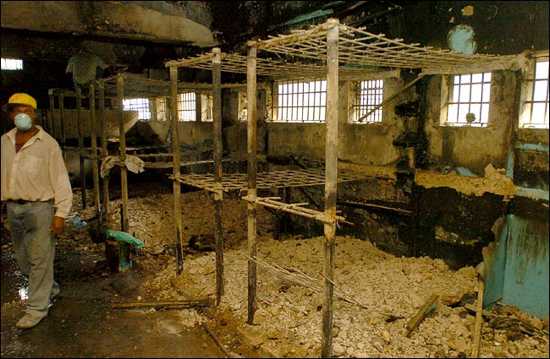
On March 7, 2005 the Higuey prison, made to hold 180 prisoners but used to house over 400, was the site of one of the worst prison fires in history up to the Comayaga Honduras prison fire. On that morning there was a riot of the prisoners at the prison. Supposedly the fight started in one wing of the prison between two sets of prison gangs and the guards were unable to control the riot. The prisoners then set fire to mattresses using weed killer to try to keep the guards away. The resulting fire and smoke killed at least 134 people and 26 more were injured. Only about 20 prisoners in the cellblock survived.
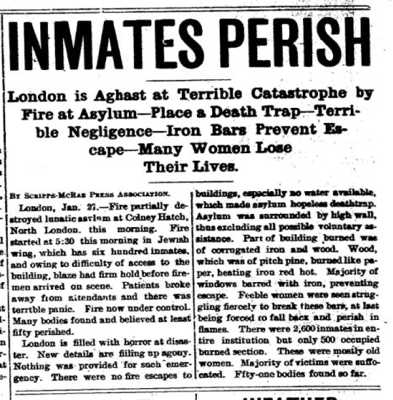
The Colney Hatch asylum was one of the earliest psychiatric prisons and was in operation from 1851-1993. Among its famous guests was John Duffy the serial killer, a possible Jack the Ripper suspect, and a woman who dressed as a man to fight on the front lines of World War I. It was a huge, sprawling complex (it was said that to walk the entire asylum took one over five hours) and housed up to 3,500 “patients.”
At around 5:30 PM on January 27, 1903, a steam whistle sounded a fire alarm at the asylum. City residents heard the siren and streamed into the London streets to see the growing blaze take hold of the building. The fire had started in one of the bottom block of wards. Soon the entire southern block, known as X Ward 5 was ablaze. The building was made of wood and the breeze fanned the flames. There were less than a dozen staff trained to fight fires in the prison fire brigade and they were quickly over matched by thee size of the blaze. The flames and smoke spread to X Ward 4 through the long corridor (said to be the longest continuous corridor in London). By the time London city firefighters arrived and were able to get water pressure, it was nearly an hour after the fire started and the entire temporary ward on the south side of the building was destroyed. The corrugated iron roof melted and collapsed. In all, five wards were destroyed. Apparently there were over 600 Jewish women (this was the Jewish ward of the building) in the five wards, but many managed to escape. The death toll was at least 52 people. Londoners were frightened that lunatics had literally escaped the asylum and were roaming the streets.
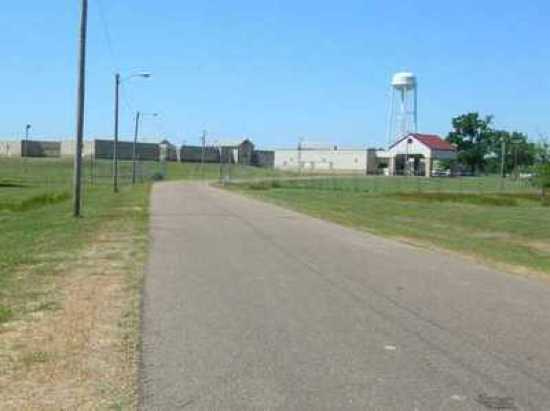
The Oakley Training School is a juvenile correctional facility located near Raymond, Mississippi and it is Mississippi’s sole juvenile correctional facility for children. Today it has a capacity of 150 students. However, it was originally called Oakley Farm and it was a State prison. Built in 1894, it failed due to poor soil in the area the women prisoners were moved to another State prison. But in 1913 it was still the Oakley Prison Farm and also the Mississippi state prison hospital and this is when the fire happened.
It is unclear how the fire started but like all buildings of the time it as constructed of wood and burned quickly. After spending the day working the cotton fields, the prisoners were locked up for the night on the second floor of the two-story prison building. When the fire started, it quickly burned the single stairs leading to the second floor. The prison had no fire apparatus to fight the fire. Local farmers ran to the prison to try to help the guards but nothing could be done. The prisoners screamed and tore at the cell bars, but no one escaped. When the fire ended, 35 prisoners, all of them African American, were dead.

The Maury County jail was located in the center of the city of Columbia Tennessee when it caught fire on Sunday June 26, 1977 during visitor’s hour. Before the fire was over, 33 inmates and 9 visitors were dead.
Unlike the older prisons that caught fire, Maury County jail was made of modern, fire-resistant construction – concrete and cinder block with few combustible building materials. However there was no fire alarm system, or sprinkler system, only fire extinguishers to fight a fire if one started. At the time of the fire there were 63 inmates, approximately 20 visitors, and 5 guards in the building. It was visiting hour and the visitors, as was the normal practice, were locked inside the jail with the prisoners.
Though the building was made of fire-resistant materials, the padding in the padded “drunk tank” was flammable – made mostly of PVC and other combustible materials, secured to plywood on the walls. Early that afternoon, a 16 year-old prisoner was moved to the drunk tank. He asked a visitor for a cigarette and the visitor gave him one, as well as his own lit cigarette to light it. At about 1:30 PM, the prisoner started yelling that his cell (the drunk tank) was on fire.
The guards opened the door to the drunk tank to rescue the prisoner (he would live as they dragged him outside) and a wall of flame and dense smoke blasted into their faces and the hallway. Visitors who were not locked in with prisoners quickly escaped but in the confusion, the guard with the keys lost them and they could not be located as the prison filled with black smoke.
Firefighters arrived quickly from the local fire department located one block from the prison, but already the building was filled with black smoke and they could not reach the prisoners trapped in their cells. They did, eventually get inside and put out the fire in the padded walls of the drunk tank. Meanwhile, firefighters using sledge hammers, cutting tools, and trucks and chains, pulled out some of the exterior walls to the prison cells and the few prisoners who escaped death managed to get out through these holes. But before it was over, 42 people were dead, most killed by carbon monoxide and cyanide gas from the burning plastic padding.

An almost identical fire to the Maury County jail fire occurred on June 21, 1977 at the Saint John city prison/holding center located inside the Saint John city hall, a 16-story high rise building in the center of the city. The building housed the city and municipal offices as well as the police and a small prison/holding area for prisoners awaiting trial. Again, the building was of modern, non-combustible construction, but contained a padded “drunk tank” holding cell. And again, this is where the fire started.
A prisoner was placed into the “drunk tank” padded cell, and a short time later other prisoners began to yell that there was fire. No one knows how he started the fire but again, as the guards arrived and opened the cell door, they were hit with a flash over of heat, smoke, and flames as the combustible and deadly gases from the burning plastic ignited. This quickly spread smoke through out the prison. Again, the guards managed to drag the prisoner out of the building and he lived, and in the confusion, again, the cell keys were lost, but quickly found. However, as guards attempted to open the metal cell doors to free the prisoners, they found the doors would not open. At first they thought the heat had melted and warped the locks but it was later determined the heat of the fire had slightly warped the metal cell doors in their sliding tracks so the doors would not slide. Firefighters had to use an acetylene torch to get into the cell block to remove the bodies.
Again, the fire itself was small and quickly extinguished, but the smoke contained deadly carbon monoxide and cyanide gas. When it was over, 21 inmates were dead.
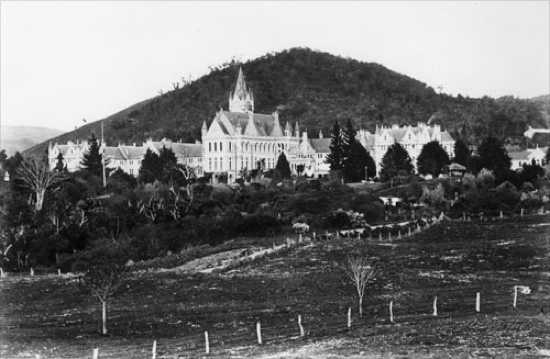
When constructed in the late 1800s, the Seacliff Lunatic Asylum was the largest building ever built in New Zealand at that time. The asylum was built in an isolated coastal spot and forested area. It could handle 500 patients with 50 staff. Created by one of New Zealand’s legendary 19th century architects, the prison was grand in scale and design. One commentator, describing the location and scale/grandiosity of the prison remarked: “The Victorians might not have wanted their lunatics living with them, but they liked to house them grandly.”
On December 8, 1942 at around 9:45 pm a fire broke out in Ward 5 of the hospital, which was a two-story, wooden “out building” added onto the original construction of the prison. It held between 39-41 female patients, all of whom were locked inside their cells or a common dormitory. Male prison workers noticed a fire in the building and quickly tried to get the fire under control using a fire hose system. But the fire spread too quickly through the wood structure and though two women were saved, the rest perished as the flames consumed the building and it collapsed. All that could be done was to prevent the fire spreading to the remainder of the building. Either 39 or 41 people, all women, died.
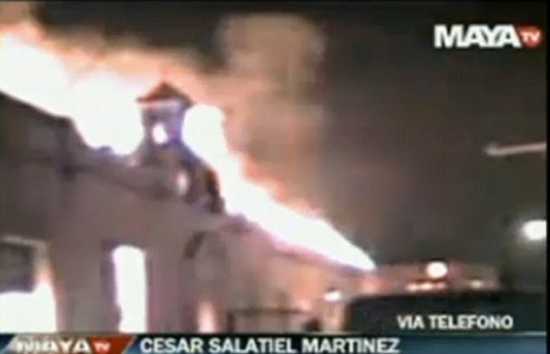
The true extent of the horror at the Comayaga Honduras prison fire of February 15, 2012 is still not known. The latest reports have more than 350 prisoners killed in the fire. Sadly, this fire was only of several recent deadly prison fires in the country of Honduras. On May 17, 2004 the San Pedro Sula prison fire killed 103 prison inmates and followed another deadly prison fire in Honduras only a year earlier. (the April 2003 prison fire at the El Porvenir Prison farm killed 86 prisoners).
San Pedro Sula is the second largest city in Honduras and it is an economic center for the small country. But it is also a center for gang violence and leads the country in the number of murders. Many of the gang members were housed in the San Pedro Sula prison. The fire allegedly started with an electrical short in a refrigerator kept by gang members in one of the cellblocks but it is also thought that one of the prison gangs intentionally set the fire. All of the victims were gang members. The prison was built to hold 800 but was holding almost 2,000 when the fire occurred.
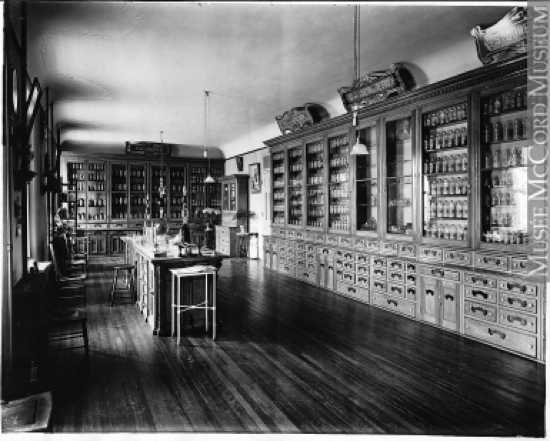
Even by the horrible standards of care received by those who were sent to 19th century insane asylums, the Longue Pointe asylum seemed to be something right out of a nightmare. The prisoners were chained, handcuffed and generally treated like animals, which was something all too common for such institutions.
Established in 1873 the Loungue Pointe asylum was one of Canada’s largest at the time and was completely operated by Catholic nuns. It held 1500 inmates. The fire originated around 11:30 AM on May 6, 1873 in the third ward in the women’s wing of the asylum. The asylum was divided into flats – the fire hit the fourth and fifth flats which each housed about 50-60 people. It was thought that one of the female inmates set fire to the building as she had previously tried to set fire to herself. Though there were fire hoses, it appears they were not connected to the pipes supplying the water. The women were of course kept locked away in the wards and it appears every one of them in the fourth and fifth flats died. When the fire was over, 94 of the women were dead as well as four Sister of Providence nuns.
An editorial in a Montreal newspaper the next day said that given the size of Lounge Pointe and the overcrowding it was only a matter of time until such a tragedy occurred. The paper blasted the lack of fire fighting apparatus and know how which could have saved many of the people and called for an investigation and reforms to be made to the asylum system in Canada as a result of the fire. The editorial asked if there were not in fact many large and similar public buildings which could also catch fire leading to huge loss of life, and wasn’t it just pure chance that fires did or did not kill? Also, they asked, “does not such an event (the fire) indicate that the whole system of Government inspection of asylums is for all practical purposes worthless?” The paper correctly pointed out that the chances of escaping a burning building are poor enough for the sane, but even less for the insane. It then went on to say, “the chances of a fire being started in such a place are greatly increased if over a thousand people living in it are lunatics.”
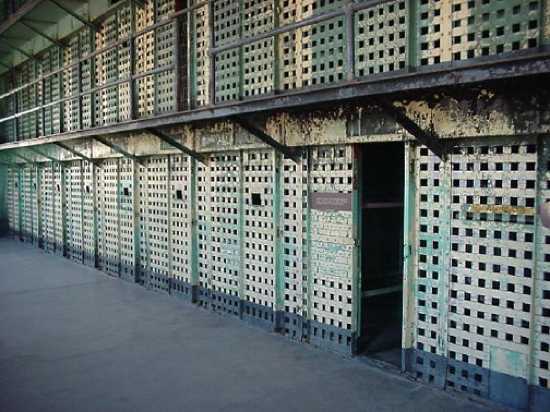
The worst prison fire in US history occurred on April 21, 1930 at the Ohio State penitentiary in which 322 people were killed. Built in 1890 and only designed to hold 1,500 prisoners, by the 1930s the Ohio State penitentiary was housing 4,300. It was undergoing renovations to add more space at the time of the fire and in fact, construction activities may have caused the fire (the cause of the fire was listed as ‘incendiary”).
What is known for certain is the fire started at around 5:00 PM just after prisoners had knocked off construction for the day. Did a prisoner set the fire as a diversionary tactic for a prison break? That was one possibility, though never proven. The fire began at the northwest corner of the prison roof. The fire quickly spread through the wood roof and frame of the six story tall prison. The guards became aware of the fire at about 5:20 PM but at first did not believe it. The guards quickly realized the fire was real and told Warden Preston Thomas. Thomas was convinced it was a prison break and delayed calling the local fire department, instead calling the local National Guard to come help keep order. By the time the Columbus Fire Department was notified 20 minutes later, they arrived to a scene of complete chaos and death as the fire raged through the wood structure with prisoners on the top two floors already being burned alive in their cells. Still, there may have bee n time to save at least the prisoners in the cells of the lower part of the prison, but guards later testified they were ordered not to unlock the cells and let the prisoners escape.
Finally, as the National Guard had arrived with the fire department, guards and the few prisoners who were not in cells desperately and heroically tried to get to the inmates still trapped inside. One man later said he had tried to reach a prisoner who was screaming from his cell “for God’s sake let me out, I’m burning!” but could not. He ran away as he could no longer stand the screams of the men dying inside.
As some of the prisoners were finally released from their cells, they attacked the firefighters for the fire hoses to try to save their fellow inmates. The National Guard had to put down a near riot. One guard reported: “we could not reach them for the bars, the convicts dropped to the floor, they were literally burned alive before our eyes.”

The full details of the February 15, 2012 fire at the prison in Comayaga Honduras are now becoming clear, and it is a horror story right out of the mind of Stephen King.
Honduras has the highest murder rate (80 per 100,000 people) in the world and has been described as a “failing state.” Gangs essentially rule the country. The country is a central area for drug and weapon trafficking between South and North America. All of the jails in the country can hold 6,000 inmates, but have over 12,000 crammed in.
At 11:00 PM on February 15, a prison inmate called the state governor Paola Castro and screamed that he was going to burn the place down. The man then set his own bed on fire. The governor dispatched fire officials to the prison who arrived but were not allowed in by the prison guards who thought the screaming they heard was part of a riot or prison break. After a delay of 30 minutes the fire fighters were allowed entrance but could find no keys to open the six barracks which each contained about 100 prisoners. All of these barracks were on fire.
It is thought that 358 died and perhaps 100 prisoners escaped but the final death toll is still unknown. Workers dragged out the charred bodies from the prison. Some inmates thought they could survive the fire by standing in the showers with the water running on them. They too died. Others were found pressing their arms against the corrugated metal roof trying to break out, piled one on top of each other.
Family members felt the fire was set by the government and was no accident. The angry crowd of relatives threatened the guards and police, who hit the crowd with tear gas and fired bullets into the ground. It is reported that half of the prisoners were not even charged with a crime and that for a prison built to hold 500, only 12 guards at night guarded the 800 inmates. One human rights documentarian stated: “When fires break out, they will not open gates to release prisoners and they die inside. It’s happened before … They haven’t learned because this is a collapsing country, they’re not interested in making change.”








